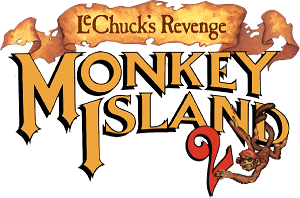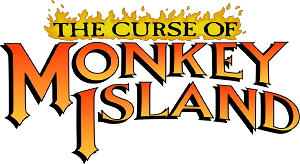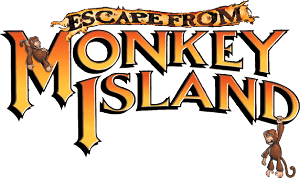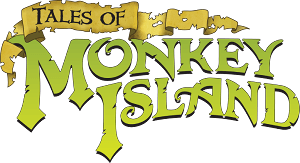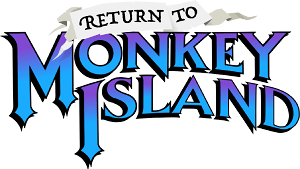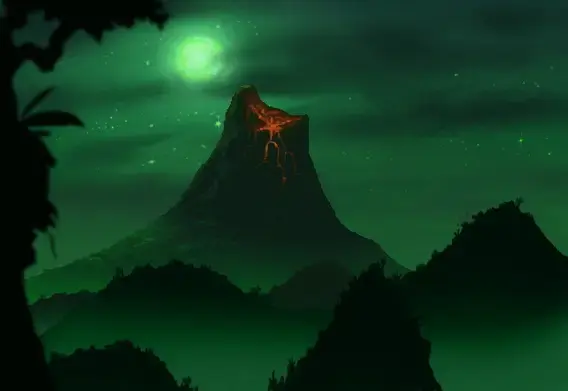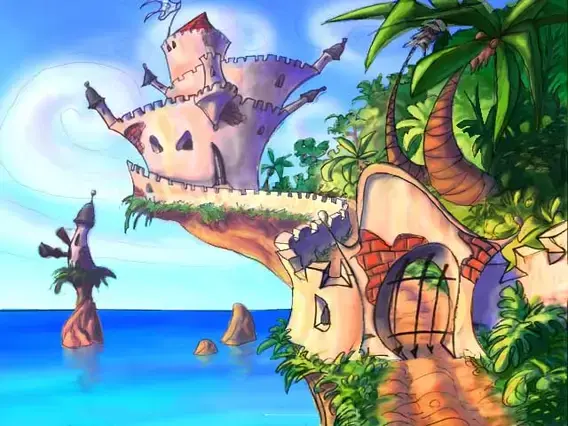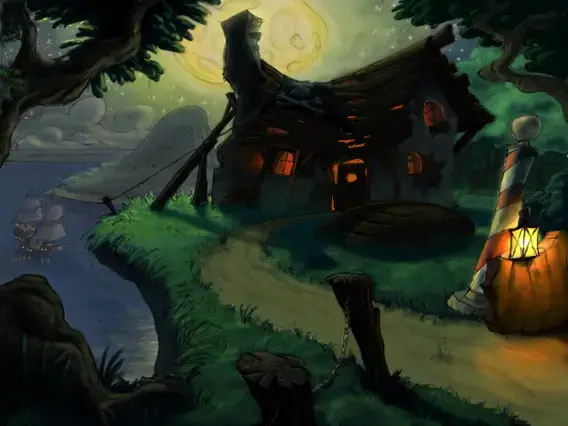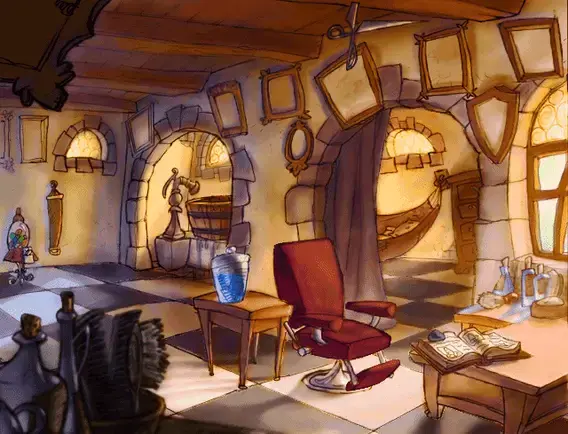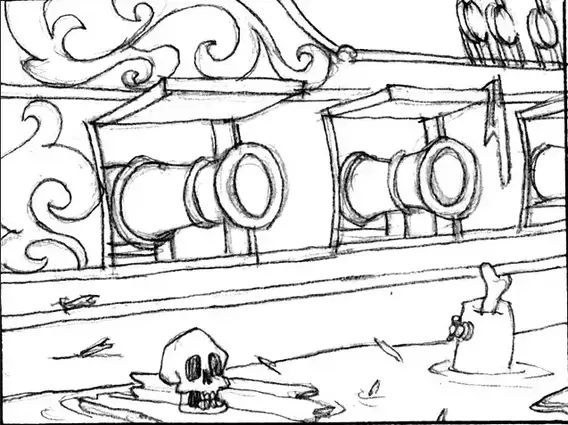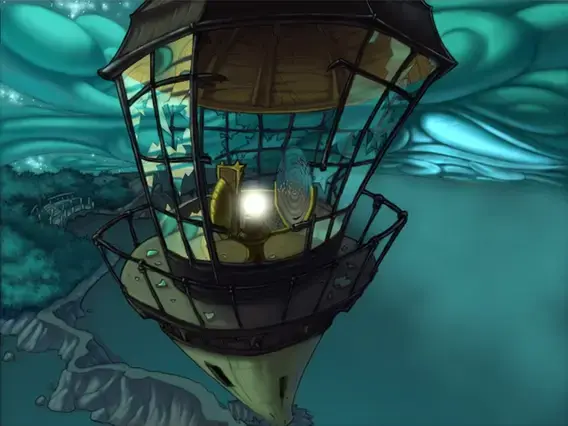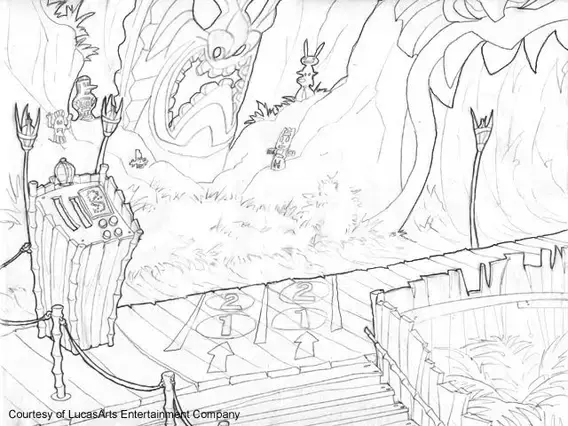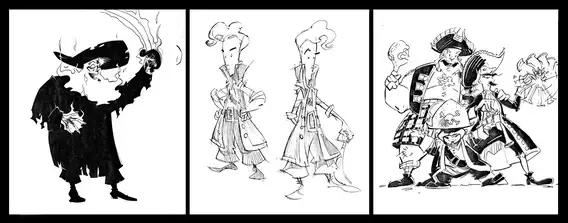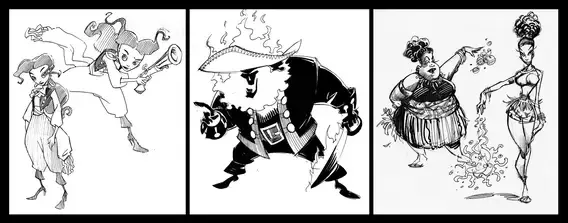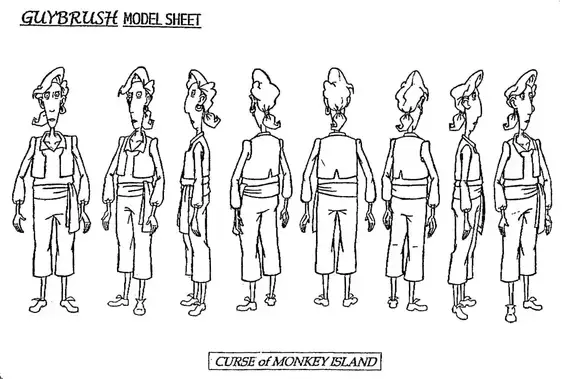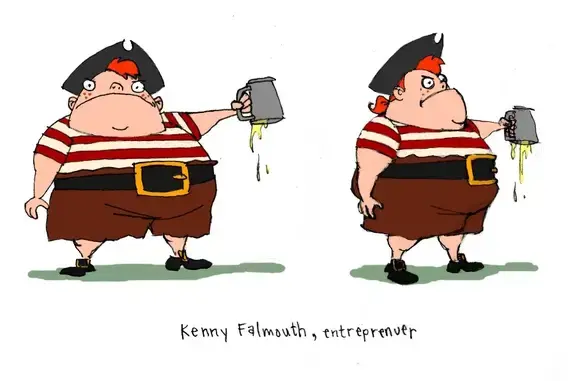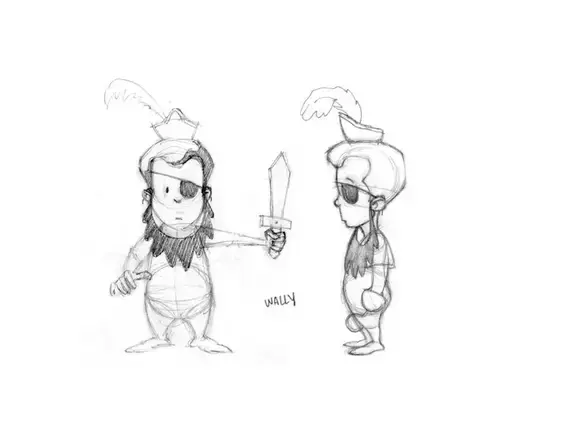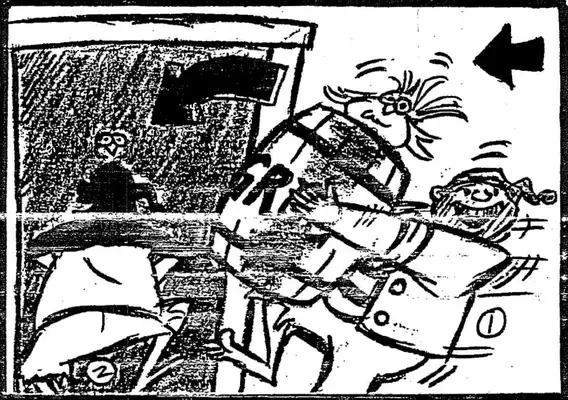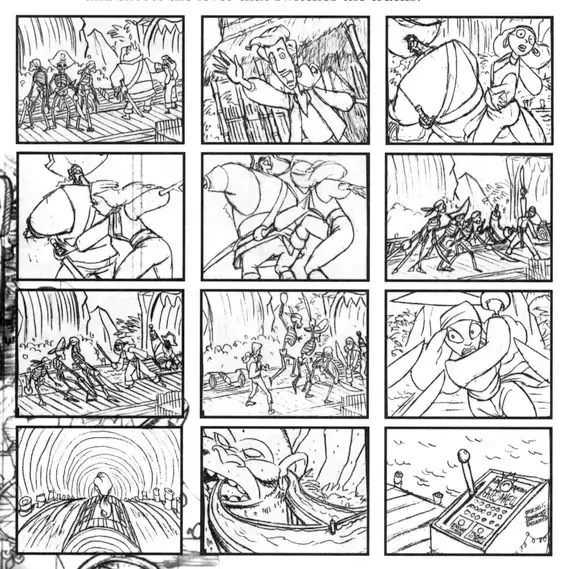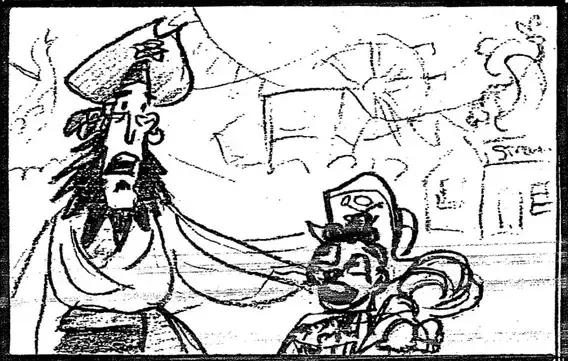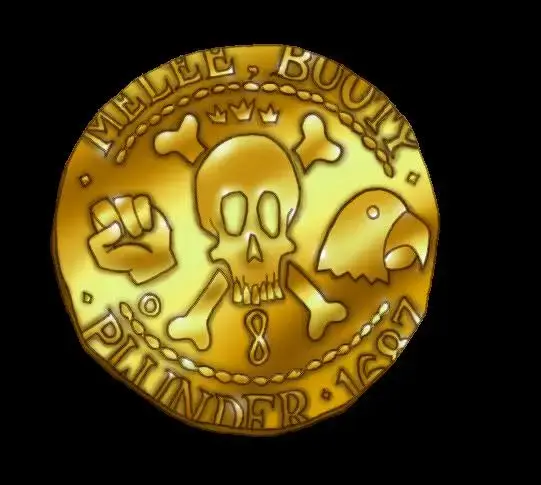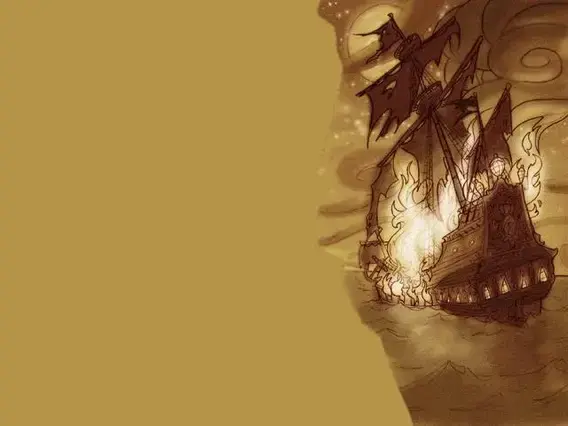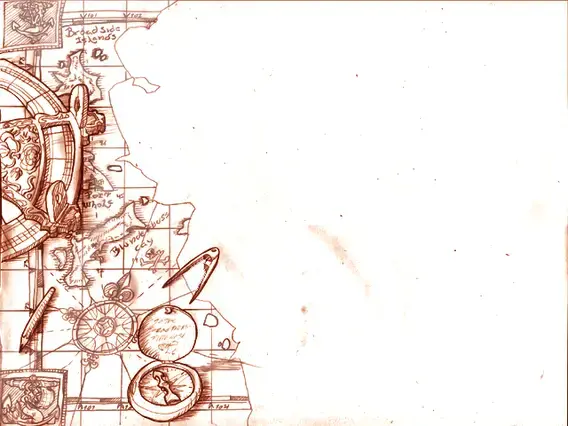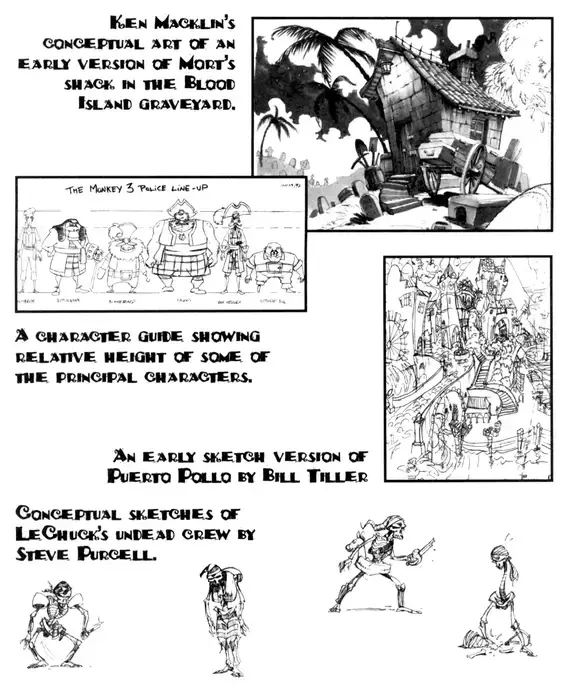Concept Art
The Curse of Monkey Island
Special thanks to Bill Tiller for providing most of the concept art on this page. Check out his point-and-click games on Steam: A Vampyre Story, Ghost Pirates of Vooju Island, and Duke Grabowski, Mighty Pirate.
Locations
Early concept art of Blood Island. Bill was inspired by a volcano he saw projected on the back wall of the interior of the Mexican Pavilion before he started working on The Curse of Monkey Island. Initially, he went with a green colour to give the game a distinctive pallet from the first two Monkey Island games.
Early design of the Plunder Island fort. Larry Ahern encouraged Bill Tiller to unleash his creativity when designing the buildings. Bill used Painter to achieve a realistic watercolour effect. However, Larry and Jonathan felt that the initial design was a bit too extravagant. In the end, they opted for a more subdued final version.
Bill’s debut in digital watercolor showcased the Barbery Coast at night with Danjer Cove beneath. It marked his first attempt at drawing curly clouds and a distinctive moon. This scene, an old pirate house, is envisioned as a haven for retired pirates. The artwork’s rough style was a deliberate choice as he was still experimenting with the watercolor look.
This initial test employed a digital watercolor method and was used to get feedback from Larry and Jonathan. They commended the style yet recommended a stronger pirate motif. Consequently, Bill enriched the color scheme and integrated a pirate-themed barber chair into the following rendition.
Line drawing of Murray floating on top of a wooden plank near LeChuck's ship. Guybrush meets Murray for the first time in this scene. This is the first ever drawing of Murray.
Coloured version and line drawing depicting the entrance to the captain’s quarters on the Sea Cucumber’s ship. This backdrop is featured in the cinematic sequence where Guybrush Threepwood and his crew experience a shipwreck on Blood Island.
Coloured version and line drawing of the Cannibal Village on Blood Island. Note that the colour of the cauldron is green, contrasting with its yellow colour in the final version.
This image of the Blood Island lighthouse, drawn by Bill Tiller and coloured by Kathy Hsieh, features a higher resolution and a greater number of colours than the version found in the game.
Coloured version and line drawing of LeChuck's chair. This background was used in the cutscenes where LeChuck is seen talking to Dinghy Dog and other recruits in his hideout located beneath Monkey Island.
Line drawing of the background where Elaine Marley was going to escape the Demon Pirate LeChuck and push him into the roller coaster. This event was planned to happen near the Monkey Head entrance on Monkey Island, but the entire sequence was discarded due to time constraints.
Coloured versions and line drawing of the Scumm Bar on Mêlée Island, rendered in the style of The Curse of Monkey Island. Bill had just finished adding the Monkey Island easter egg to Indiana Jones and the Infernal Machine. Still inspired by Monkey Island, he decided to create this sketch purely for fun while waiting for his wife to finish her work at LucasArts.
In 2020, Bill Tiller created a high-resolution, repainted version of the background art for the Barber Shop. He aimed to use this artwork to convince Disney to release a new HD version of The Curse of Monkey Island. He produced two variations of this artwork, one with a darker theme and the other lighter. However, this concept is still a work in progress as it lacks the shadows of the table and chair.
Coloured version and line drawing of the original Puerto Pollo Chicken Shop before it was added into the final long panning shot. By 2022, Bill Tiller began creating a tutorial video for a client interested in learning his digital painting style. This led to the creation of this concept based on a sketch he made in 1997.
Characters
Pen-on-paper sketch of LeChuck, Guybrush, and the barbers from the Barbery Coast. The Guybrush version shown here depicts Steve’s attempt at manipulating his form like silly putty.
Pen-on-paper sketch of Elaine, LeChuck and the Voodoo Lady. Elaine is a variation on a design Larry Ahern had done.
This concept art was included in the audition material provided to the voice-casting director and actors. This character's sketches helped them understand the specific voice requirements for each character.
This concept art was included in the audition material provided to the voice-casting director and actors. This character's sketches helped them understand the specific voice requirements for each character.
More concept art that was included in the audition material provided to the voice-casting director and actors.
This concept art was included in the audition material provided to the voice-casting director and actors. This character's sketches helped them understand the specific voice requirements for each character.
Storyboards
The game underwent two stages of storyboarding. The first was a ‘rough’ stage, primarily for working out the story elements. The second was a ‘tight’ stage, where the artwork closely mirrored the final product and served as a guide for the animators. This is a storyboard from a short sequence from the game's opening to demonstrate the progression of a scene through these three stages - rough, tight, and final.
This storyboard depicts the cutscene in which the Thin Pirate and Fat Pirate gather debris and assorted objects - including a barrel of grog and a chicken - adrift on the sea near the coast of Plunder Island.
In this discarded storyboard sequence, LeChuck is on the verge of placing Elaine on his diabolical roller coaster when she seizes his sword. Together, she and Guybrush fend off the skeletal masses. Amid the chaos, Guybrush is hurled onto the roller coaster, seemingly destined for a fiery end. However, Elaine notices the controls and fires at the lever, altering the tracks’ direction.
Other
A higher-resolution image of the verb coin interface used in the game to interact with objects and people. The coin has three actions: the hand (to pick up or use), the skull eyes (to examine), and the parrot (to talk or eat).
Clean map texture used as Palido Domingo's tattoo. This map is the one that Guybrush peels from Palido’s back and uses to navigate to Blood Island. The map includes Plunder Island, Blood Island, and Skull Island.
Coloured version and line drawing of one of the closing credits backgrounds. This drawing is based on a photo from a book called "Pirates: Worldwide Illustrated History" by David Cordingly.
Coloured background of one of the closing credits screens. Also based on a photo from the "Pirates: Worldwide Illustrated History" book by David Cordingly.
